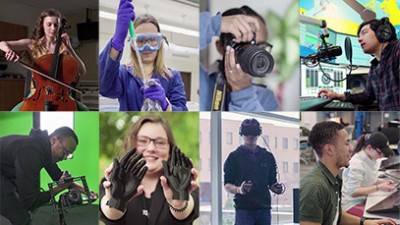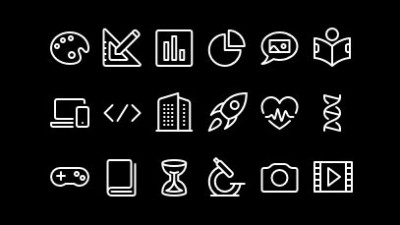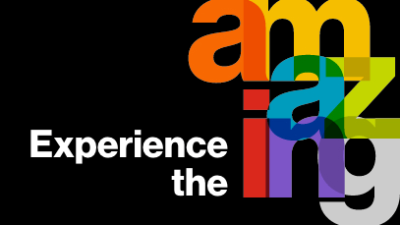Science and Math News
- RIT/
- Academics/
- Areas of Study/
- Science and Math/
- Science and Math News
-
August 3, 2020
![professor looking at laptop.]()
RIT faculty gearing up to apply spring learnings to fall classes
The unexpected transition to remote learning during the spring semester challenged faculty across RIT to experiment, create, and deploy new methods of instruction to ensure student success. As the university gears up for in-person and online classes—or a combination of both—faculty members are applying a wide range of lessons learned from the spring to keep academic momentum moving forward in the fall.
-
July 31, 2020
![marijuana made with an electron microscope with the word MIXED stamped on it.]()
Is This a Pic of Marijuana Under a Scanning Electron Microscope?
Snopes.com talks to Ted Kinsman, associate professor of photographic sciences, about how images are made with the scanning electron microscope.
-
July 31, 2020
![professor sitting at his desk in the 1980s.]()
Douglas Merrill retires from RIT after 40 years, establishes student fund
Douglas Merrill, who inspired countless students during his 40-year tenure in the College of Science and the College of Health Sciences and Technology, has retired. He developed the Premedical Advisory Program and created the Center for Bioscience Education and Technology. And he retires with numerous honors recognizing his outstanding teaching and commitment to diversity and inclusion.
-
July 22, 2020
![professor writing on chalkboard.]()
Groundbreaking study of binary star evolution is focus of new NSF grant
A new grant will help researchers at NTID learn more about “one of the most challenging phases in stellar astrophysics,” according to the National Science Foundation.
-
July 16, 2020
![illustration of round cells fitting into holes on a surface.]()
Researchers develop new method to filter extracellular vesicles to improve diagnostics options
Researchers at RIT and the University of Rochester discovered an alternative to successfully purify biological particles to better understand how cells communicate with one another.
-
June 23, 2020
![screenshot of program that searches math formulas.]()
RIT researchers create easy-to-use math-aware search interface
Researchers at RIT have developed MathDeck, an online search interface that allows anyone to easily create, edit and lookup sophisticated math formulas on the computer. Created by an interdisciplinary team of more than a dozen faculty and students, MathDeck aims to make math notation interactive and easily shareable, and it's is free and open to the public.
-
June 23, 2020
![three researchers working on a drone.]()
RIT’s Digital Imaging and Remote Sensing Laboratory now offering services to the public
Through the Digital Imaging and Remote Sensing (DIRS) Enterprise Center, customers can now hire faculty and staff from RIT’s Chester F. Carlson Center for Imaging Science to provide training, consulting, data collection, equipment calibration and more in relation to drones, imaging and remote sensing technology.
-
June 18, 2020
![x-ray flare from a very young star.]()
X-rays From a Newborn Star Hint at Our Sun's Earliest Days
NASA mentions Joel Kastner, professor in the Chester F. Carlson Center for Imaging Science and School of Physics and Astronomy, and alumnus David Principe '10 Ph.D. (astrophysical science and technology) for being part of a team that observed an X-ray flare from a very young star using NASA's Chandra X-ray Observatory.
-
June 18, 2020
![Hubble image of gas and dust ejected from a star.]()
Hubble Provides Holistic View of Stars Gone Haywire
NASA features Joel Kastner, a professor in RIT’s Chester F. Carlson Center for Imaging Science and School of Physics and Astronomy, and astrophysical science and technology Ph.D. students Jesse Bublitz and Paula Moraga on their latest Hubble telescope observations.
-
June 5, 2020
![professor helping student put on virtual reality headset.]()
RIT faculty earns NIH grant to use virtual reality to help stroke patients regain lost vision
Scientists from RIT and the University of Rochester aim to use virtual reality to help restore vision for people with stroke-induced blindness. The team of researchers led by RIT's Gabriel Diaz, are developing a method they believe could revolutionize rehabilitation for patients with cortically induced blindness, which afflicts about 1% of the population over age 50.
-
June 4, 2020
![man speaking at podium next to the Bolivian flag.]()
RIT Rallies: Biotechnology alumnus helping Bolivia respond to COVID-19 pandemic
Mohammed Mostajo-Radji ’11 (biotechnology) was appointed as Bolivia’s first ambassador for science, technology and innovation in February. He is typically based out of Silicon Valley, helping to encourage technology investment in Bolivia. But on March 19 he flew back home at the request of Bolivia’s interim president, Jeanine Áñez, to help coordinate his country’s efforts to combat COVID-19’s spread.
-
June 2, 2020
![Three 3D printers creating PPE equipment.]()
RIT Rallies: WNY Fighting Covid takes aim at PPE shortage
Founded by a group of RIT Alumni, the grassroots organization looks to put homemade masks and other protective equipment in the hands of Western New York front line workers.





















